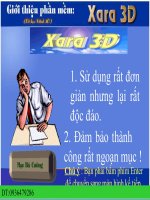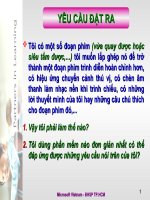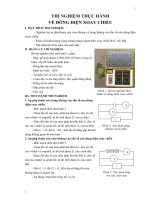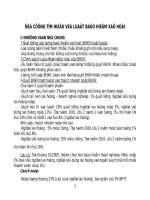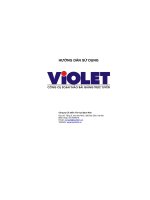Hướng dẫn sử dụng LINGO OPTIMIZATION
Bạn đang xem bản rút gọn của tài liệu. Xem và tải ngay bản đầy đủ của tài liệu tại đây (11.52 MB, 963 trang )
COPYRIGHT
The LINGO software and its related documentation are copyrighted. You may not copy the LINGO
software or related documentation except in the manner authorized in the related documentation or
with the written permission of LINDO Systems Inc.
TRADEMARKS
LINGO is a trademark, and LINDO is a registered trademark, of LINDO Systems Inc. Other product
and company names mentioned herein are the property of their respective owners.
DISCLAIMER
LINDO Systems, Inc. warrants that on the date of receipt of your payment, the software provided
contains an accurate reproduction of the LINGO software and that the copy of the related
documentation is accurately reproduced. Due to the inherent complexity of computer programs and
computer models, the LINGO software may not be completely free of errors. You are advised to verify
your answers before basing decisions on them. NEITHER LINDO SYSTEMS, INC. NOR ANYONE
ELSE ASSOCIATED IN THE CREATION, PRODUCTION, OR DISTRIBUTION OF THE LINGO
SOFTWARE MAKES ANY OTHER EXPRESSED WARRANTIES REGARDING THE DISKS OR
DOCUMENTATION AND MAKES NO WARRANTIES AT ALL, EITHER EXPRESSED OR
IMPLIED, REGARDING THE LINGO SOFTWARE, INCLUDING THE IMPLIED WARRANTIES
OF MERCHANTABILITY, FITNESS FOR A PARTICULAR PURPOSE, OR OTHERWISE.
Further, LINDO Systems, Inc. reserves the right to revise this software and related documentation and
make changes to the content hereof without obligation to notify any person of such revisions or
changes.
Copyright © 2016 by LINDO Systems Inc. All rights reserved.
Published by
1415 North Dayton Street
Chicago, Illinois 60642
Technical Support: (312) 988-9421
E-mail:
WWW:
Contents
Contents ................................................................................................................................................ iii
Preface ................................................................................................................................................. vii
New Features ........................................................................................................................................ xi
for LINGO 16.0 ...................................................................................................................................... xi
1 Getting Started with LINGO ............................................................................................................ 1
Getting Started on Windows............................................................................................................. 1
Getting Started on a Mac ................................................................................................................. 9
Getting Started on Linux................................................................................................................. 20
Creating and Solving a Model in LINGO ........................................................................................ 32
Examining the Solution Report ....................................................................................................... 46
Intro to LINGO’s Modeling Language ............................................................................................. 48
Additional Modeling Language Features ........................................................................................ 60
Indicating Convexity and Concavity ............................................................................................... 64
Maximum Problem Dimensions ...................................................................................................... 65
How to Contact LINDO Systems .................................................................................................... 66
2 Using Sets ...................................................................................................................................... 67
Why Use Sets?............................................................................................................................... 67
What Are Sets? .............................................................................................................................. 67
The Sets Section of a Model .......................................................................................................... 68
The DATA Section.......................................................................................................................... 74
Set Looping Functions.................................................................................................................... 75
Set-Based Modeling Examples ...................................................................................................... 82
Summary .......................................................................................................................................101
3 Using Variable Domain Functions ..............................................................................................103
Integer Variables ...........................................................................................................................103
Free Variables ...............................................................................................................................122
Bounded Variables ........................................................................................................................127
SOS Variables ...............................................................................................................................128
Cardinality .....................................................................................................................................132
Semicontinuous Variables .............................................................................................................132
Positive Semi-Definite Matrices .....................................................................................................134
4 Data, Init and Calc Sections ........................................................................................................139
The DATA Section of a Model .......................................................................................................139
The INIT Section of a Model..........................................................................................................143
The CALC Section of a Model .......................................................................................................144
Summary .......................................................................................................................................149
iv
CONTENTS
5 Menu Commands..........................................................................................................................151
Accessing Menu Commands .........................................................................................................151
Menu Commands In Brief..............................................................................................................154
Menu Commands In Depth ...........................................................................................................158
1. File Menu...................................................................................................................................158
2. Edit Menu ..................................................................................................................................176
3. Solver Menu ..............................................................................................................................189
4. Window Menu............................................................................................................................309
5. Help Menu .................................................................................................................................313
6 Command-Line Commands .........................................................................................................319
The Commands In Brief ................................................................................................................319
The Commands In Depth ..............................................................................................................321
7 LINGO’s Operators and Functions..............................................................................................421
Standard Operators .......................................................................................................................421
Mathematical Functions ................................................................................................................425
Financial Functions .......................................................................................................................428
Probability Functions .....................................................................................................................428
Variable Domain Functions ...........................................................................................................431
Set Handling Functions .................................................................................................................432
Set Looping Functions...................................................................................................................437
Interface Functions ........................................................................................................................439
Distributions...................................................................................................................................440
Report Functions ...........................................................................................................................447
Date, Time and Calendar Functions ..............................................................................................458
Matrix Functions ............................................................................................................................462
Miscellaneous Functions ...............................................................................................................476
8 Interfacing with External Files .....................................................................................................479
Cut and Paste Transfers ...............................................................................................................479
Text File Interface Functions .........................................................................................................481
LINGO Command Scripts ..............................................................................................................489
Specifying Files in the Command-line ...........................................................................................492
RunLingo .......................................................................................................................................494
Redirecting Input and Output ........................................................................................................497
Managing LINGO Files ..................................................................................................................497
9 Interfacing With Spreadsheets ....................................................................................................499
Importing Data from Spreadsheets................................................................................................499
Exporting Solutions to Spreadsheets ............................................................................................504
OLE Automation Links from Excel .................................................................................................512
Embedding LINGO Models in Excel ..............................................................................................516
Embedding Excel Sheets in LINGO ..............................................................................................522
Summary .......................................................................................................................................526
CONTENTS
v
10 Interfacing with Databases ..........................................................................................................527
ODBC Data Sources .....................................................................................................................528
Importing Data from Databases with @ODBC ..............................................................................535
Importing Data with ODBC in a PERT Model ................................................................................537
Exporting Data with @ODBC ........................................................................................................539
Exporting Data with ODBC in a PERT Model ................................................................................542
11 Interfacing with Other Applications ............................................................................................547
The LINGO Dynamic Link Library..................................................................................................547
User Defined Functions .................................................................................................................591
12 Developing More Advanced Models ...........................................................................................595
Production Management Models ...................................................................................................596
Logistics Models ............................................................................................................................612
Financial Models ...........................................................................................................................619
Queuing Models ............................................................................................................................636
Marketing Models ..........................................................................................................................644
13 Programming LINGO ....................................................................................................................653
Programming Features..................................................................................................................653
Programming Example: Binary Search .........................................................................................687
Programming Example: Markowitz Efficient Frontier .....................................................................691
Programming Example: Cutting Stock...........................................................................................698
Programming Example: Accessing Excel ......................................................................................704
Summary .......................................................................................................................................711
14 Stochastic Programming ...........................................................................................................713
Multistage Decision Making Under Uncertainty .............................................................................713
Recourse Models ..........................................................................................................................715
Scenario Tree ................................................................................................................................717
Monte Carlo Sampling ...................................................................................................................719
Setting up SP Models ....................................................................................................................720
Language Features for SP Models ................................................................................................721
Declaring Distributions ..................................................................................................................723
Gas Buying Example .....................................................................................................................730
Stock Option Example ...................................................................................................................741
Investing Under Uncertainty Example ...........................................................................................750
Chance-Constrained Programs (CCPs) ........................................................................................757
15 On Mathematical Modeling ..........................................................................................................771
Solvers Used Internally by LINGO.................................................................................................771
Type of Constraints .......................................................................................................................772
Local Optima vs. Global Optima ....................................................................................................774
Smooth vs. Nonsmooth Functions.................................................................................................780
Guidelines for Nonlinear Modeling ................................................................................................781
vi
CONTENTS
Appendix A: Additional Examples of LINGO Modeling................................................................783
Appendix B: Error Messages .........................................................................................................873
Appendix C: Bibliography and Suggested Reading.....................................................................925
Acknowledgements ............................................................................................................................927
Index ....................................................................................................................................................929
Preface
LINGO is a comprehensive tool designed to make building and solving mathematical optimization
models easier and more efficient. LINGO provides a completely integrated package that includes a
powerful language for expressing optimization models, a full-featured environment for building and
editing problems, and a set of fast built-in solvers capable of efficiently solving most classes of
optimization models. LINGO's primary features include:
Algebraic Modeling Language
LINGO supports a powerful, set-based modeling language that allows users to express math
programming models efficiently and compactly. Multiple models may be solved iteratively using
LINGO's internal scripting capabilities.
Convenient Data Options
LINGO takes the time and hassle out of managing your data. It allows you to build models that
pull information directly from databases and spreadsheets. Similarly, LINGO can output solution
information right into a database or spreadsheet making it easier for you to generate reports in the
application of your choice. Complete separation of model and data enhance model maintenance
and scalability.
Model Interactively or Create Turnkey Applications
You can build and solve models within LINGO, or you can call LINGO directly from an
application you have written. For developing models interactively, LINGO provides a complete
modeling environment to build, solve, and analyze your models. For building turn-key solutions,
LINGO comes with callable DLL and OLE interfaces that can be called from user written
applications. LINGO can also be called directly from an Excel macro or database application.
LINGO currently includes programming examples for C/C++, FORTRAN, Java, C#.NET,
VB.NET, ASP.NET, Visual Basic, Delphi, and Excel.
Extensive Documentation and Help
LINGO provides all of the tools you will need to get up and running quickly. You get the LINGO
Users Manual (in printed form and available via the online Help), which fully describes the
commands and features of the program. Also included with Super versions and larger is a copy of
Optimization Modeling with LINGO, a comprehensive modeling text discussing all major classes
of linear, integer and nonlinear optimization problems. LINGO also comes with dozens of realworld based examples for you to modify and expand.
Powerful Solvers and Tools
LINGO is available with a comprehensive set of fast, built-in solvers for linear, nonlinear (convex
& nonconvex), quadratic, quadratically constrained, and integer optimization. You never have to
specify or load a separate solver, because LINGO reads your formulation and automatically
selects the appropriate one. A general description of the solvers and tools available in LINGO
follows:
viii PREFACE
General Nonlinear Solver
LINGO provides both general nonlinear and nonlinear/integer capabilities. The nonlinear license
option is required in order to use the nonlinear capabilities with LINDO API.
Global Solver
The global solver combines a series of range bounding (e.g., interval analysis and convex
analysis) and range reduction techniques (e.g., linear programming and constraint propagation)
within a branch-and-bound framework to find proven global solutions to nonconvex nonlinear
programs. Traditional nonlinear solvers can get stuck at suboptimal, local solutions. This is no
longer the case when using the global solver.
Multistart Solver
The multistart solver intelligently generates a sequence of candidate starting points in the solution
space of NLP and mixed integer NLPs. A traditional NLP solver is called with each starting point
to find a local optimum. For non-convex NLP models, the quality of the best solution found by the
multistart solver tends to be superior to that of a single solution from a traditional nonlinear solver.
A user adjustable parameter controls the maximum number of multistarts to be performed.
Barrier Solver
The barrier solver is an alternative way for solving linear, quadratic and conic problems. LINGO's
state-of-the-art implementation of the barrier method offers great speed advantages for large-scale,
sparse models.
Simplex Solvers
LINGO offers two advanced implementations of the primal and dual simplex methods as the
primary means for solving linear programming problems. Its flexible design allows the users to
fine tune each method by altering several of the algorithmic parameters.
Mixed Integer Solver
The mixed integer solver’s capabilities of LINGO extend to linear, quadratic, and general
nonlinear integer models. It contains several advanced solution techniques such as cut generation,
tree reordering to reduce tree growth dynamically, and advanced heuristic and presolve strategies.
Stochastic Solver
The stochastic programming solver supports decision making under uncertainty through
multistage stochastic models with recourse. The user describes the uncertainty by identifying the
distribution functions, either built-in or user-defined, describing each random variable. The
stochastic solver will optimize the model to minimize the cost of the initial stage plus the expected
cost of future recourse actions over the planning horizon. Advanced sampling modes are also
available for approximating continuous distributions. LINGO's stochastic solver also supports
chance-constrained models, where one or more sets of constraints are allowed to be violated
according to a specified probability.
PREFACE
ix
Model and Solution Analysis Tools
LINGO includes a comprehensive set of analysis tools for debugging infeasible linear, integer and
nonlinear programs, using advanced techniques to isolate the source of infeasibilities to the
smallest subset of the original constraints. It also has tools to perform sensitivity analysis to
determine the sensitivity of the optimal basis to changes in certain data components (e.g. objective
vector and right-hand-size values).
Quadratic Recognition Tools
The QP recognition tool is a useful algebraic pre-processor that automatically determines if an
arbitrary NLP is actually a convex, quadratic model. QP models may then be passed to the faster
quadratic solver, which is available as part of the barrier solver option. When the barrier solver
option is combined with the global option, LINGO will automatically recognize conic models, in
addition to convex quadratic models.
Linearization Tools
Linearization is a comprehensive reformulation tool that automatically converts many non-smooth
functions and operators (e.g., max and absolute value) to a series of linear, mathematically
equivalent expressions. Many non-smooth models may be entirely linearized. This allows the
linear solver to quickly find a global solution to what would have otherwise been an intractable
nonlinear problem.
New Features
for LINGO 16.0
LINDO Systems is proud to introduce LINGO 16.0. The new features added to LINGO since the
initial release of LINGO 15.0 include the following:
1. LP Solver Improvements:
With new enhancements to the simplex solvers, the average performance has increased
by 35% for the primal simplex and 20% for the dual simplex.
2. MIP Solver Improvements:
A new optimization mode has been introduced to ensure reproducibility of runs.
Improved K-Best algorithm with new cuts and threshold strategies.
New heuristic algorithms help to find significantly better solutions for many models with
knapsack constraints and block structures.
New MIP preprocessing level devoted to tightening variable bounds for some nonlinear
models.
3. Stochastic Solver Improvements:
Improved cut management for Nested Benders Decomposition Method leading to speed
improvements over 60% for larger instances.
Better handling of multistage models which do not have full-recourse.
Extensions to the parser which allow the use of arbitrarily complex functions of
stochastic parameters.
4. Global Solver Improvements:
Introduces a new global solver for quadratic problems based on SDP. This feature
dramatically improves the performance and solves previously intractable problems to
global optimality.
Incorporates a new bound tightening process to the linearization procedure and improves
solvability of linearized model.
xii PREFACE
5. Native Macintosh Support:
LINGO's user interface has been entirely rewritten to offer native support for the
Macintosh. Below is an image of the Mac version running a small nonlinear program.
Notice the syntax highlighting, etc:
6. GUI Interface for Linux Versions of Lingo:
In the past, Linux versions had a command-line interface, as opposed to the easier to use
GUI interface found on Windows versions. Linux versions of LINGO now have a full
GUI interface similar to the Windows version's interface.
7. Matrix Functions:
There have been a number of new functions were added to LINGO for performing matrix
operations. Supported operations include: eigenvalues and eigenvector computation,
matrix determinant, Cholesky factorization, matrix inverse, and matrix transpose.
8. Linear Regression:
The new @REGRESS function for multiple linear regression has been added.
PREFACE
xiii
9. Other Improvements:
Tornado charts now supported.
Additional sorting capabilities, convenient for data preparation and solution reporting.
A new date function, @STM2YMD, for converting LINGO's standard time values into the
equivalent calendar date and time.
We hope you enjoy this new release of LINGO. Many of the new features in this release are due to
suggestions from our users. In particular, we'd like to thank both Robert Coughlan and Wu Jian (Jack)
for their many useful suggestions for improving LINGO. If there are any features you'd like to see in
the next release of LINGO, please let us know. Feel free to reach us at:
LINDO Systems Inc.
1415 N. Dayton St.
Chicago, Illinois 60642
(312) 988-7422
April 2016
1 Getting Started with
LINGO
LINGO is a simple tool for utilizing the power of linear and nonlinear optimization to formulate large
problems concisely, solve them, and analyze the solution. Optimization helps you find the answer that
yields the best result; attains the highest profit, output, or happiness; or the one that achieves the lowest
cost, waste, or discomfort. Often these problems involve making the most efficient use of your
resources-including money, time, machinery, staff, inventory, and more. Optimization problems are
often classified as linear or nonlinear, depending on whether the relationships in the problem are linear
with respect to the variables.
If you are a new user, it is recommended you go through the first seven chapters of this document to
familiarize yourself with LINGO. Then you may want to see On Mathematical Modeling for more
information on the difference between linear and nonlinear models and how to develop large models. It
may also be helpful to view some sample models in Developing More Advanced Models or Additional
Examples of LINGO Modeling to see if a particular template example is similar to a problem you have.
For users of previous versions of LINGO, the new features are summarized in the Preface at the
beginning of the manual.
Getting Started on Windows
Installing LINGO on Windows
Installing the LINGO software is straightforward. To setup LINGO for Windows, place your CD in the
appropriate drive and run the installation program SETUP contained in the LINGO folder.
Alternatively, if you downloaded LINGO from the LINDO website, locate the download installation
program and double-click it to run the installation. The LINGO installation program will open and
guide you through the steps required to install LINGO on your hard drive.
Note:
If there is a previous version of LINGO installed on your machine, then you may need to
uninstall it before you can install the new copy of LINGO. To uninstall the existing copy of
LINGO, click on the Windows Start button, select the Settings command, select Control
Panel, then double-click on the Add or Remove Programs icon. You should then be able to
select LINGO and have the old version removed from your system.
2 CHAPTER 1
Starting LINGO on Windows
Once LINGO is installed, you will find a new Lingo icon on your desktop:
You may double-click on the icon to start LINGO. Once LINGO is running, your screen will resemble
the following:
The outer window labeled LINGO is the main frame window. All other windows will be contained
within this window. The top of the frame window also contains all the command menus and the
command toolbar. See Menu Commands for details on the toolbar and menu commands. The lower
edge of the main frame window contains a status bar that provides various pieces of information
GETTING STARTED
3
regarding LINGO's current state. Both the toolbar and the status bar can be suppressed through the use
of the Options command.
The smaller child window labeled LINGO Model - LINGO1 is a new, blank model window. In the next
section, we will be entering a sample model directly into this window.
Many copies of LINGO come with their licenses pre-installed. However, some versions of LINGO
require you to input a license key. If your version of LINGO requires a license key, you will be
presented with the following dialog box when you start LINGO:
Your license key may have been included in an email sent to you when you ordered your software.
The license key is a string of letters, symbols and numbers, separated into groups of four by hyphens
(e.g., r82m-XCW2-dZu?-%72S-fD?S-Wp@). Carefully enter the license into the edit field,
including hyphens. License keys are case sensitive, so you must be sure to preserve the case of the
individual letters when entering your key. Click the OK button and, assuming the key was entered
correctly, LINGO will then start. In the future, you will be able to run LINGO directly without
entering the key.
Note:
If you received your license key by email, then you have the option of cutting-and-pasting it
into the license key dialog box. Cut the key from the email that contains it with the Ctrl+C
key, then select the key field in LINGO dialog box and paste the key with the Ctrl+V key.
4 CHAPTER 1
If you don’t have a key, you can choose to run LINGO in demo mode by clicking the Demo button. In
demo mode, LINGO has all the functionality of a standard version of LINGO with the one exception
that the maximum problem size is restricted. Demo licenses expire after 180 days.
Opening a Sample Model on Windows
LINGO is shipped with a directory containing many sample models. These models are drawn from a
wide array of application areas. For a complete listing of these models, see Additional Examples of
LINGO Modeling. The sample model directory is titled Samples and is stored directly off the many
LINGO directory.
To open a sample model in LINGO, follow these steps:
1. Pull down the File menu and select the Open command. You should see the following dialog
box:
GETTING STARTED
5
2. Double-click on the folder titled Samples contained in the main LINGO folder installed off your
root folder, at which point you should see:
6 CHAPTER 1
3. To read in a small transportation model, type Tran in the File Name field in the above dialog
box and press the Open button. You should now have the model in an open window in LINGO as
follows:
For details on developing a transportation model in LINGO see The Problem in Words in Getting
Started with LINGO.
GETTING STARTED
You may now solve the model using the Solver|Solve command or by pressing the
button on the
toolbar. The optimal objective value for this model is 161. When solved, you should see the following
solver status window:
Note the objective field has a value of 161 as expected. For an interpretation of the other fields in this
window, see Solver Status Window in Getting Started with LINGO.
7
8 CHAPTER 1
Behind the solver status window, you will find the solution report for the model. This report contains
summary information about the model as well as values for all the variables. This report’s header is
reproduced below:
For information on interpreting the fields in the solution report, see Sample Solution Report in Getting
Started with LINGO.
GETTING STARTED
9
Getting Started on a Mac
Installing LINGO on a Mac
LINGO for the Mac is distributed as a .DMG file, or disk image file,
titled LINGO-OSX-64x86-16.0.dmg. If you double-click on this file you should see a window similar
to the following:
To install LINGO onto your Mac, drag the LINGO icon in the window to the Applications folder icon.
This will place a copy of LINGO in the /Applications folder of your hard drive. The Mac version of
LINGO requires that you have installed OS X 10.7, or later, on your system.
10 CHAPTER 1
We also recommend that you drag a copy of the LingoDocs folder in the above window to your hard
drive. The LingoDocs folder contains copies of LINGO's sample models and documentation. You may
want to place this folder in your $HOME folder (subsequent documentation will assume this is the
case).
Starting LINGO on a Mac
Once LINGO is installed, you will find a new LINGO icon in the /Applications folder on your Mac's
hard drive. The icon should appear as follows:
GETTING STARTED
11
You may double-click on the icon to start LINGO. Once LINGO is running, your screen will resemble
the following:
The outer window is the main frame window, and all other windows will be contained within this main
frame window. The top of the main frame window also contains a toolbar for executing various
LINGO commands.
The smaller child window labeled Lingo Model - Lingo1.lng is a new, blank model window. In the
Developing a LINGO Model section, we will be entering a sample model directly into this window.



